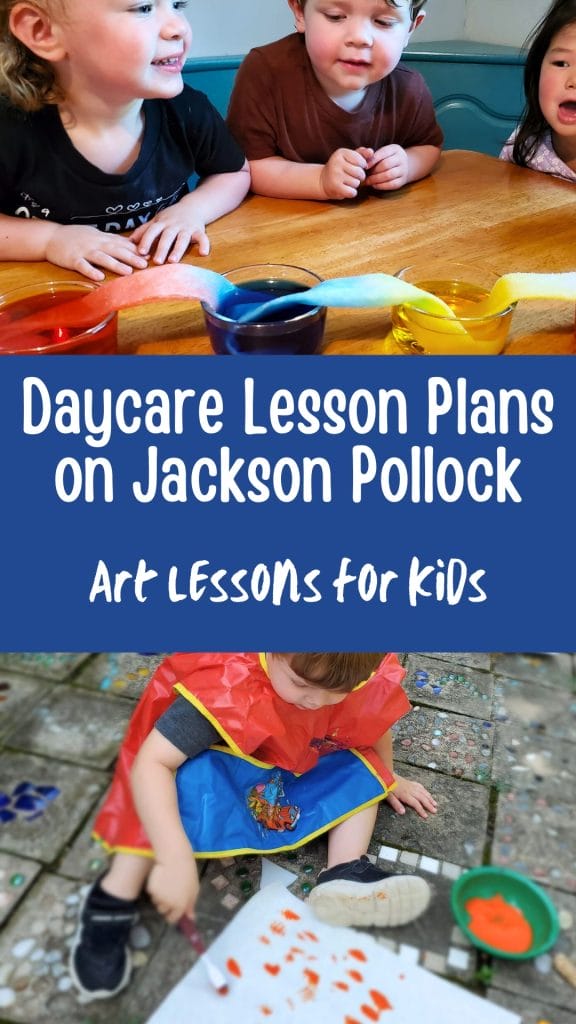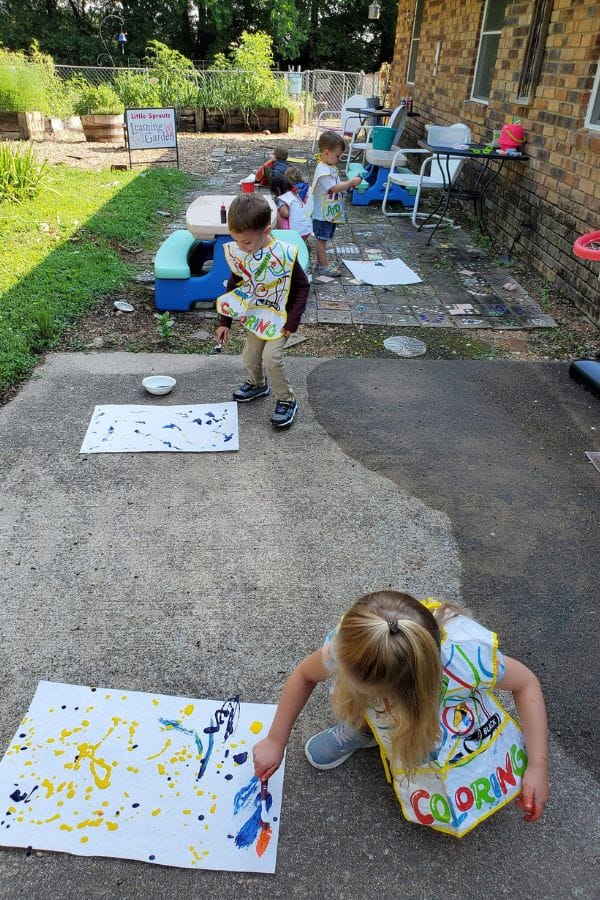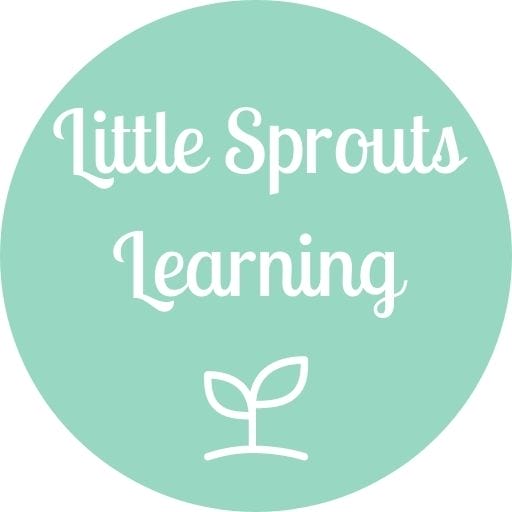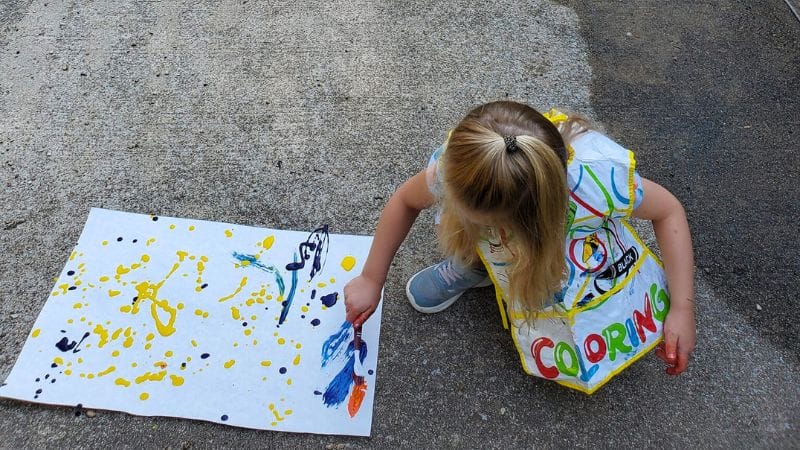Daycare Lesson Plans on Jackson Pollock
This page may contain affiliate links. Learn More.
If you want to explore fun abstract art, check out these daycare lesson plans on Jackson Pollock. There is so much children can learn from this type of art study and enrichment curriculum for daycare. Your young artists can make these great works of art with liquid paint.

Jackson Pollock loved to create big, colorful paintings by splashing and dripping paint all over his canvas. His art was full of energy and excitement! We’re going to explore his unique style and even try making a Pollock-inspired masterpiece.
The significance of art in child development
Art plays a vital role in the development of young children, offering numerous benefits that contribute to their overall growth and well-being. Here are some key reasons why art is significant in child development:
- Creativity and Imagination: Engaging in artistic activities encourages children to use their imagination and think creatively. This fosters innovation and problem-solving skills that are essential in many areas of life.
- Fine Motor Skills: Activities like drawing, painting, and sculpting help develop fine motor skills and hand-eye coordination. These skills are crucial for tasks such as writing and using tools.
- Emotional Expression: Art provides a safe outlet for children to express their emotions and feelings. Through creative expression, children can process their experiences and communicate what might be difficult to put into words.
- Cognitive Development: Artistic activities stimulate cognitive development by encouraging children to plan, analyze, and make decisions. Understanding concepts like colors, shapes, and patterns enhances their intellectual growth.
- Cultural Awareness: Exploring different forms of art from various cultures helps children develop an appreciation for diversity and broadens their understanding of the world around them.
- Self-Esteem and Confidence: Completing art projects gives children a sense of accomplishment and boosts their self-esteem. Positive reinforcement from caregivers and peers further enhances their confidence.
- Social Skills: Group art activities promote collaboration, communication, and sharing. Children learn to work together, respect each other’s ideas, and build social relationships.
- Relaxation and Stress Relief: Engaging in art can be a calming and therapeutic activity, helping children manage stress and relax.
By incorporating art into daily activities, caregivers and educators can support children’s holistic development, helping them grow into well-rounded individuals.
If you want more art ideas and how to throw the perfect art celebration for kids, check this out.
Jackson Pollock art and life
Jackson Pollock was an artist who was born in 1912 in the United States. He is famous for making big, beautiful paintings by dripping and splashing paint all over a canvas. Imagine if you could make art by dancing with your paintbrush – that’s kind of what Jackson Pollock did!
They called him action Jackson for his drip paintings and is one of the most colorful famous artists we know. His artistic style of abstract expressionism is unlike anyone else. And he was an American artist!
Pollock’s Art Style
Jackson Pollock’s way of painting is called “abstract.” This means his paintings don’t look like real things like people, animals, or places. Instead, they are all about colors, shapes, and lines. His style is called “drip painting” because he used sticks, brushes, and even his hands to drip and pour paint onto his canvas.
- Big Canvases: Jackson Pollock liked to make really big paintings, sometimes as big as the walls in a room!
- Action Painting: He would put his canvas on the floor and move around it, dripping and splashing paint from all sides. It was like a dance!
- Messy Fun: Making Pollock-style art can be a little messy, but it’s so much fun. Don’t worry if paint gets everywhere – that’s part of the creativity!
For printable Jackson Pollock lesson plans that include a schedule, lesson plans including the Oklahoma ELG’s, and list of supplies needed, check this out on Etsy.
Drip art project painting famous artist
Jackson Pollock’s art is full of colors and looks very exciting, just like a big, happy mess! Drip painting is a way of making art by letting paint drip and splash onto a canvas. Instead of using a paintbrush to draw pictures, we let the paint make its own shapes and patterns. It’s all about having fun and being creative! Lesson plans on Jackson Pollock are great for kids because of this.
I like to do a little bit of a unique style of lesson plans with my daycare kids. I love to use fine arts to teach them concepts and start them out with culture and knowledge. Here are some more of my specialized daycare lesson plans for toddlers and preschoolers.
- Daycare Lesson Plans on Henri Matisse teach kids about collage, painting, sculpture and more.
- For kindness, friendship, and farm life, check out Daycare lesson plans on “Anne of Green Gables”
- Daycare Lesson Plans on Huck Finn will teach kids about camping, rafting, and friendship and loyalty.
- These Daycare Lesson Plans on Irish Culture help kids understand other cultures and the richness of the Irish people.
- Daycare Lesson Plans on Picasso is a fine art study for toddlers that teaches about abstract art.
- Daycare Lesson Plans on Shakespeare is an enrichment activity set that features poetry, drama, rhyming, and dramatic play.
- Daycare Lesson Plans on Korean Culture feature unique qualities, foods, and traditions of the Korean culture.
- Kids have a lot of fun with these Daycare Lesson Plans on Jean-Michel Basquiat with lots of relatable art mediums and cultural interest.
- Daycare Lesson Plans on Frida Kahlo is full of rich color and vibrant paintings.
- Daycare Lesson Plans on Andy Warhol for pop art inspiration.
- Daycare Lesson Plans on Native American Culture is an enrichment set that shows traditional practices of the Native American people.
- Daycare Lesson Plans on “The Secret Garden” teaches about friendship, gardening, and fun!
- Daycare Lesson Plans on French Culture features traditional food and activities in the French culture.
Here are a ton more helpful printables you can get to make your business easier!
And more helpful tools for providers here. I wish I would have had access to these years ago, they are such a blessing!

Art lesson plan on Jackson Pollock
Introduction to Jackson Pollock
- Read Jackson Pollock Splashed Paint and Wasn’t Sorry by Fausto Gilberti
Learn about Pollock art
- Show the kids paintings online or in books by Jackson Pollock to let them get familiar with the style
- Talk about what they like and don’t like about the paintings and if they think they were fun to make
- Talk about his love for lots of color

Splatter Paint
- Spread out the newspaper or plastic sheets on the floor to protect the area. Give each child a large sheet of paper or canvas and an apron or old clothes. Set up washable tempera paint with different materials to splash with. Sticks, brushes, sponges, toothbrushes, and more.
- Encourage the children to use the different tools to drip, splatter, and squeeze paint onto their paper or canvas. Remind them to move around and have fun with it.
- Allow the children to experiment with mixing colors and creating different patterns. Offer positive reinforcement and encourage them to express themselves freely.

Dripping Paint
- Prepare the area with newspaper or plastic sheets. Provide each child with a canvas and cups of washable paints with small amounts in them.
- Play lively music and encourage the children to move around their canvas, dripping paint to the rhythm of the music.
Crawling Rainbow (Color mixing)
- Make 4 bowls of water and add food coloring to each. Two red, one blue, and one yellow. This is a great way to teach about primary colors and how to mix them.
- Roll strips of paper towels and put each end in a different color of water. Ex: One paper towel will have one end dipped in red water and one in yellow. The next one will have one end in yellow and the other end in blue. The next one will have one end in blue and the other end in red.
- The color will bleed up from each bowl and make secondary colors where they meet.

Spin Painting
- Put Tempera paints in squeeze bottles.
- Put small pieces of paper (A sheet of construction paper cut into 4 squares will work) in a salad spinner.
- Make spin paint by spinning the spinner as fast as you can with the lid on.
Collaborative Painting
- Roll out the large paper or canvas on the floor. Spread out newspaper or plastic sheets to protect the area.
- Divide the children into small groups. Each group takes turns dripping and splattering paint on the large canvas.
- Encourage children to communicate and work together, sharing tools and space.
Gallery Wall
- Create a gallery wall in the classroom to display the children’s Pollock-inspired artworks.
- Send a note home to parents explaining the activity and encouraging them to ask their children about Jackson Pollock and their painting experience. Or set up a gallery showing and invite them to come and look at the children’s works.







